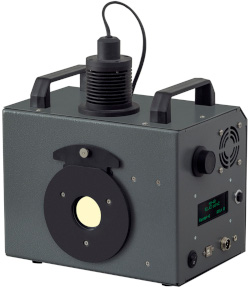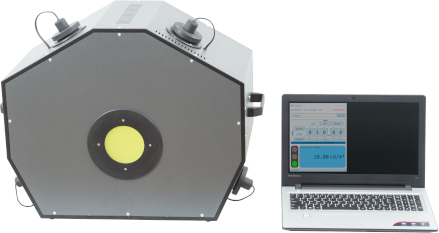Light sources
There are many low cost artificial light sources used for illumination or for industrial applications: tungsten or halogen bulbs, fluorescent lamps, LED lamps etc. Some of these sources offer regulated intensity of emitted light. However, there are very few calibrated light sources of precisely known photometric/radiometric parameters. A light source can be considered as calibrated when its user can precisely regulate its photometric/radiometric parameters like luminance (or illuminance), radiance (or irradiance) at defined spectrum of interest. Such light sources are needed in many applications including systems for testing night vision devices, VIS-NIR cameras and SWIR imagers. Another critical requirement on professional calibrated light sources is ability to simulate illumination conditions met at real life conditions. Practically it means ultra high dynamic of regulation of light intensity to simulate both day/night conditions and to simulate different light spectrum.
Inframet offers a series of calibrated light sources that can be divides into two groups:
1. Light sources designed for Inframet
test systems,
2. Univeral Lambertian light
sources.
The light sources from the first group (coded as LS-DAL, LS-SAL, LS-MAH, LS-COHL ) are optimized to be used in systems for testing VIS-SWIR cameras. In detail, they are to be used as light sources in image projectors based on off axis reflective collimators. Therefore, light emission angle of these sources is relatively narrow (up to about 20°) in order to minimize light reflections that can limit contrast of images projected by such collimators. It should be noted that these light sources of narrow emission angle can be used also in a series of other application. The first three light sources are computerized sources targeted for hight end applications. The last light source is manual light source targeted for budget limited applications.
LS-DAL/LS-SAL light sources work by combining light from two main channels: halogen bulb of 2856K color temperature spectrum and several LED sources. Intensity of the halogen bulb is regulated using an opto-mechanical attenuator that changes light intensity but does not change light color temperature. Intensity of the LED sources is regulated electronically using advanced electronic regulation/stabilization system. Regulation of spectrum of emitted light is additionally supported by aset of external spectral filters. DAL/SAL light sources look externally the same but there are some design differences: different coating of integrating sphere, slightly different halogen source and different LED sources. DAL is optimized for testing VIS-NIR cameras sensitive up to about 1000 nm; SAL - for testing SWIR imagers sensitive up to about 1700 nm.
LS-COHL can be treated as a special more advanced version of LS-DAL/SAL sources. LS-DAL/SAL light sources are generally broadband light sources. LS-COHL can work also in broadband mode but offers also variable wavelength monochromatic mode. In this mode LS-COHL can emit ligh in narrow spectral band of wavelength requlated by the user. Up to eight wavelengths located in VIS-SWIR range is typically possible.
Basic version of LS-MAH light source is a broadband (emitting light in wide range from visible to short infrared) non calibrated (user can regulate luminance but absolute value is not known) targeted for budget limited projects. The light source when combined with a collimator and a set of targets can create simple but near perfect solution for measurement of imaging parameters (resolution, MTF, distortion) of VIS-NIR cameras, SWIR imagers and with limitations also NVDs.
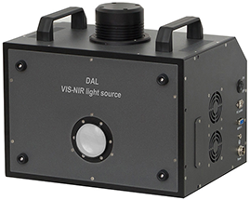 Fig. 1. LS-DAL light source |
 Fig. 2. LS-SAL light source |
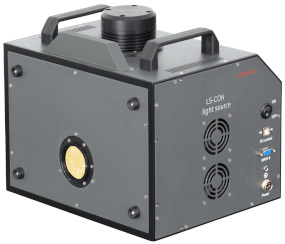 Fig. 3. LS-COHL light source |
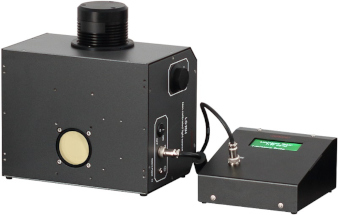 Fig. 4.LS-MAH light source |
LS-LAM series light sources are sources that emits light in almost total hemisphere like near perfect Lambertian sources. They can be treated as typical integrating spheres built by combining integrating module with opto-mechanical attenuator, electronics in one case to improve source reliability and mobility. They typically use halogen light source that emit light of 2856K spectrum.
Inframet can deliver LS-LAM sources of emitter size up to 300mm in both manual and computerized version. Below are presented photos of two popular models: manual LS-LAM40M and computerized LS-LAM100C.
|
|
Learn more:
- Data sheets:LS-DAL, LS-SAL, LS-COHL, LS-MAH, LS-LAM40, LS-LAM100C
- Inframet Info section
- Inframet Newsletter
- Contact INFRAMET

